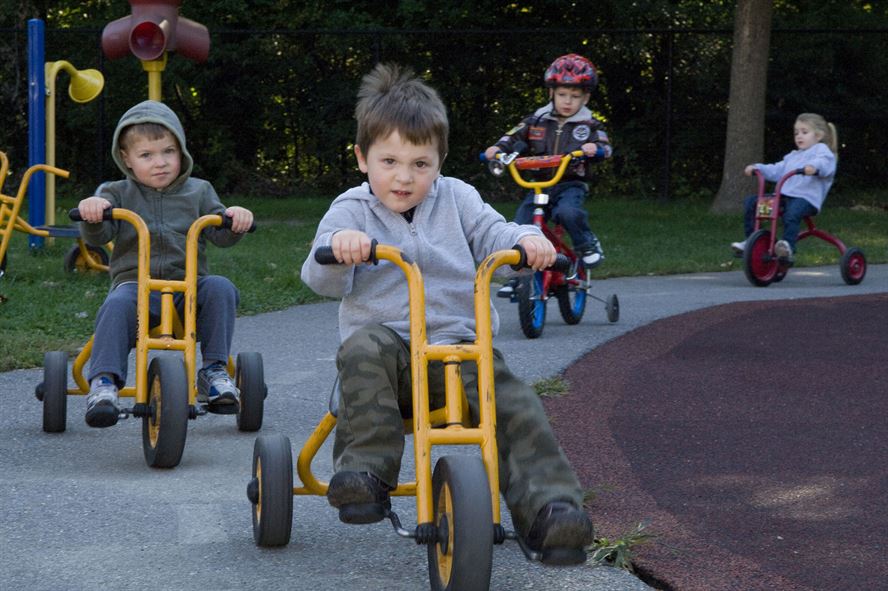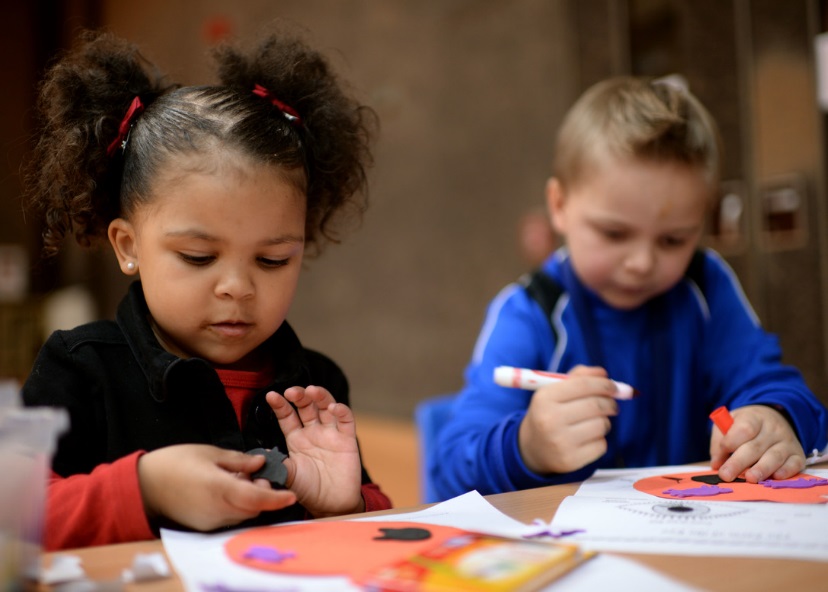Early childhood is a time when children are especially attracted to motion and song. Days are filled with jumping, running, swinging and clapping and every place becomes a playground. Even the booth at a restaurant affords the opportunity to slide around in the seat or disappear underneath and imagine being a sea creature in a cave! Of course, this can be frustrating to a caregiver, but it’s the business of early childhood.
Gross Motor Skills
Early childhood is the time period when most children acquire the basic skills for locomotion, such as running, jumping, and skipping, and object control skills, such as throwing, catching, and kicking (Clark, 1994). Children continue to improve their gross motor skills as they run and jump. Fine motor skills are also being refined in activities, such as pouring water into a container, drawing, coloring, and buttoning coats and using scissors. The development of greater coordination of muscles groups and finer precision can be seen during this time period. Thus, average 2-year-olds may be able to run with slightly better coordination than they managed as a toddler, yet they would have difficulty peddling a tricycle, something the typical 3-year-old can do.
Here is a table showing the progression of gross motor skills that children will typically develop during early childhood:
|
Typical Age |
What Most Children Do by This Age |
|
3 years |
|
|
4 years |
|
|
5 years |
|
Activities to Support Gross Motor Skills
Here are some activities focused on play that young children enjoy and that support their gross motor skill development.
- Tricycle
- Slides
- Swings
- Sit-n-Spin
- Mini trampoline
- Bowling pins (can use plastic soda bottles also)
- Tent (try throwing blankets over chairs and other furniture to make a fort)
- Playground ladders
- Suspension bridge on playground
- Tunnels (try throwing a bean bag chair underneath for greater challenge)
- Ball play (kick, throw, catch)
- Simon Says
- Target games with bean bags, ball, etc.
- Dancing/moving to music
- Pushing self on scooter or skateboard while on stomach

Children riding tricycles together. [Image by Hanscom Air Force Base is in the public domain]
Fine Motor Skills
We see similar changes in fine motor skills with 4-year-olds who no longer struggle to put on their clothes, something they may have had problems with two years earlier. Motor skills continue to develop into middle childhood, but for those in early childhood, play that deliberately involves these skills is emphasized.
Here is a table showing how fine motor skills progress during early childhood for children that are typically developing.
|
Typical Age |
What Most Children Do by This Age |
|
3 years |
|
|
4 years |
|
|
5 years |
|
Activities to Support Fine Motor Skills
Here are some fun activities that will help children continue to refine their fine motor abilities. Fine motor skills are slower to develop than gross motor skills, so it is important to have age appropriate expectations and play-based activities for children.
- Pouring water into a container
- Drawing and coloring
- Using scissors
- Finger painting
- Fingerplays and songs (such as the Itsy, Bitsy Spider)
- Play dough
- Lacing and beading
- Practicing with large tweezers, tongs, and eye droppers

Children coloring. [Image by Spangdahlem Air Base is in the public domain]
Attributions
“Lifespan Development: A Psychological Perspective” by Martha Lally and Suzanne Valentine-French is licensed under CC BY-NC-SA 3.0
“Physical Development During Childhood” by Troianne T. Grayson, Mary Wuergler, and Michael Konrad, Child and Adolescent Psychology is licensed under CC BY 4.0
“Child Growth and Development” by Jean Zaar is licensed under CC BY 4.0 / A derivative from the original work
